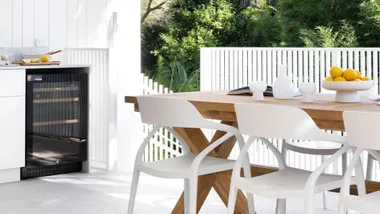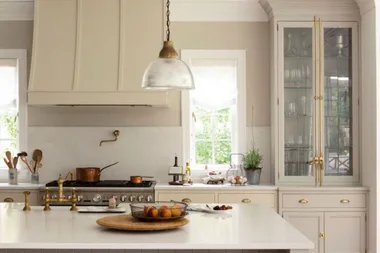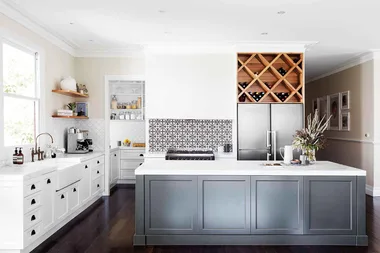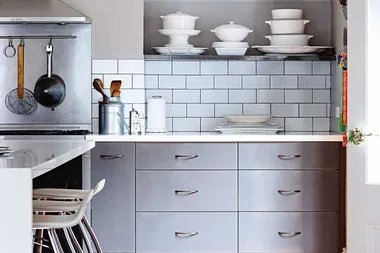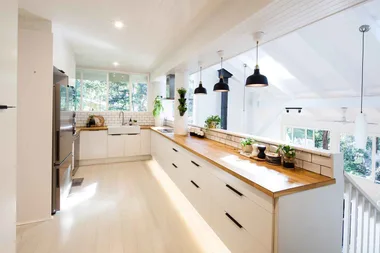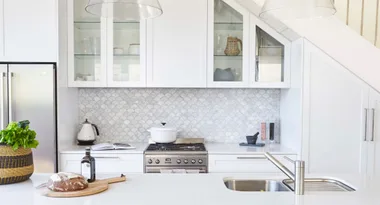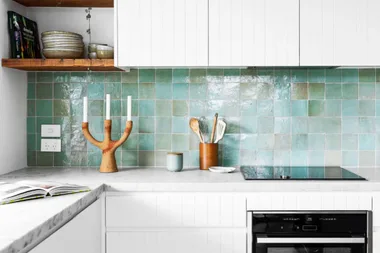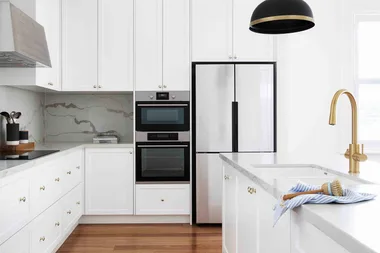The kitchen cabinet doors you choose will play a big part in informing the look of your home. “The profile of cabinet fronts is important as it supports the style, era and design direction of the rest of your house,” says Kathryn Durham, interior designer at Purpose Build.
The cupboards you go with will also have functional impacts. “When deciding on the profile, consider how easy it is to clean,” says Kathryn. “Also consider what surrounding materials you plan on using near the cabinetry to ensure you don’t create lines that fight each other and make the space look busy.”
Kitchen cabinet door styles
We run through the most popular cabinetry looks, and the home styles they suit.
Fluted
Fluted or ribbed kitchen cabinets lend themselves beautifully to two-pack polyurethane finishes in your chosen colour. Some timber veneer profiles also come in fluted or ribbed slats that can be used to clad your cabinetry fronts. Try the look at home for a warm retro feel or as a highlight – for example, on your island bench cabinetry – within an otherwise pared-back space.

“Many people and designers are starting to use multiple profiles in the one space,” says Kathryn. Here, NXN Interiors integrated appliances behind boldly ribbed MDF cabinetry, alongside motorised free-fold thin Shaker drawers, both by Scandinavian Profiles. The juxtaposition of the dark Dulux Castlecliff and bright Dulux Mt Aspiring completes the dramatic contrast.
Mesh
Cupboard doors with semi-obscured, mesh inlay panels are ideal to break up a run of plain cabinetry. Enduringly popular in farmhouse style, newer metal mesh designs can add a chic industrial note or a glamorous, brass-toned highlight to your kitchen. Rattan inlays are also having a moment – especially in coastal abodes – and instantly achieve a relaxed, tactile look.
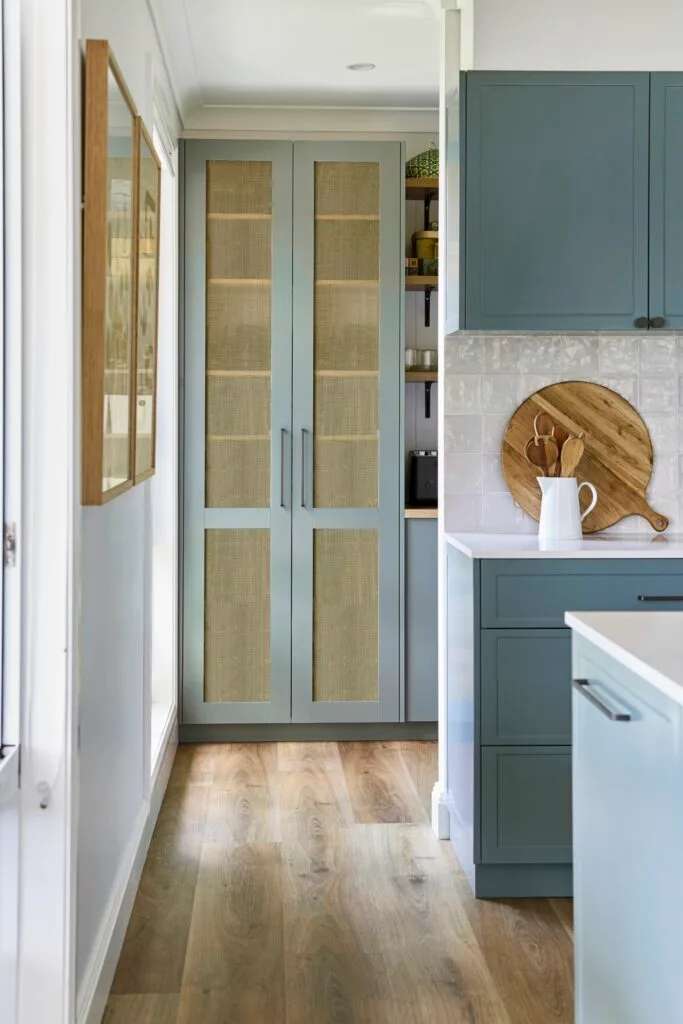
Minimalist
Minimalist, unadorned doors and drawers suit a range of home styles, especially modern and contemporary interiors. “The smooth, flat profile is timeless,” explains Kathryn. It’s also the perfect backdrop for statement hardware and lets the finish do the talking. Textural materials, such as timber veneer or even microcement, can add interest to flat-fronted joinery. With no framing to distract the eye, it’s also great for small kitchens.
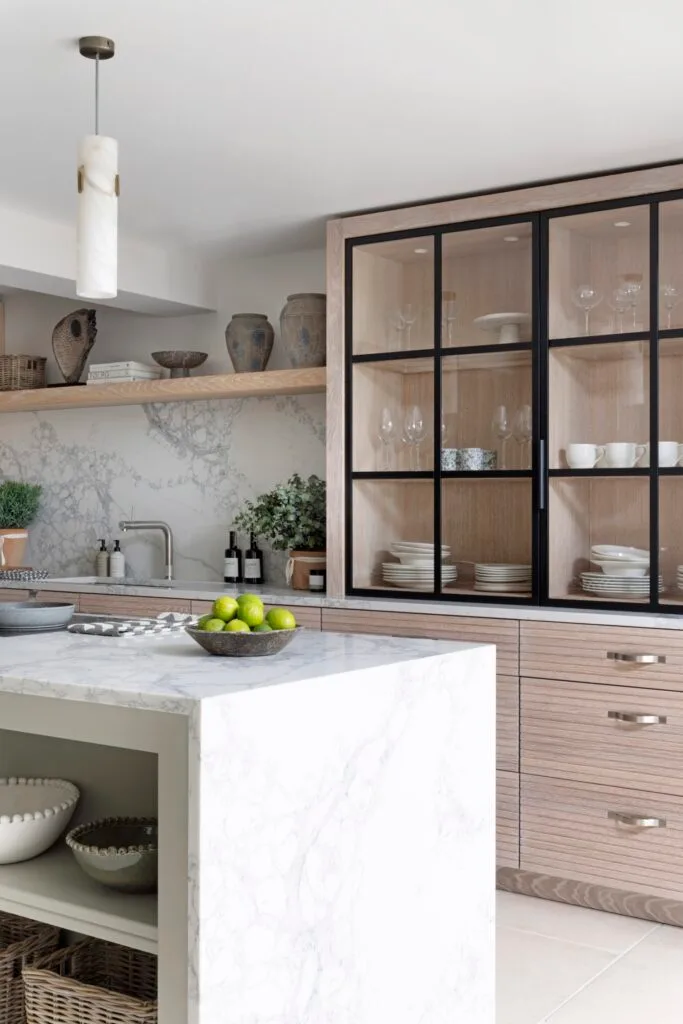
Founder of Humphrey Munson, Peter Humphrey, designed this kitchen with modern sensibilities in mind. Portman oak is used on the lower cabinetry, paired with brushed nickel handles. The upper cabinetry fronts are glass, with handles seamlessly integrated into the frame of the doors. Plates and glasses are stacked and stored in effortlessly chic displays.
Shaker
Shaker cupboards and drawers feature horizontal rails and vertical stiles that make up a clean surface frame. Their relaxed but elegant aesthetic is ideal for modern, Hamptons and coastal-style homes. The width of these rails and stiles is what can take Shaker profiles from one interior style to another. For a modern look, choose a thinner width; for a traditional feel, use a wider measurement. “There’s an emerging preference for sleeker, more contemporary interpretations of this style,” explains Giorgia Manenti, content lead at Kaboodle Kitchen.
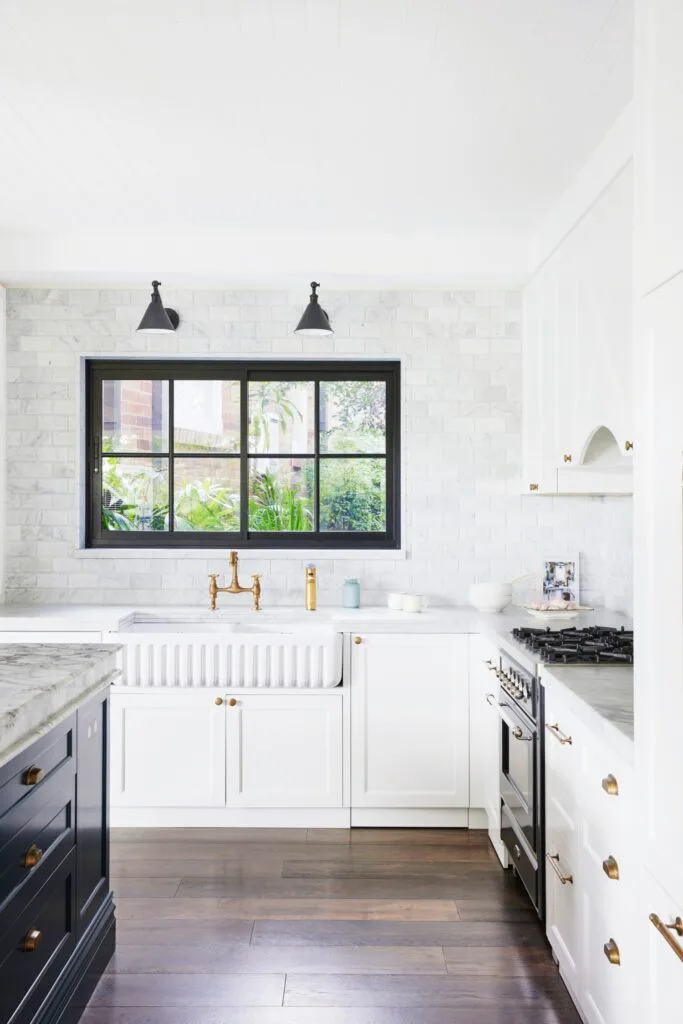
Clear
Glazed joinery is a staple of Hamptons-style kitchens, but retro influences are making themselves felt here, too, in the form of fluted and reeded glass. This glazing is more forgiving than regular glass, which shows fingerprints and necessitates scrupulously tidy cupboards. While glass requires a little more maintenance, there’s something joyful about seeing carefully curated displays. “We’ve noticed a growing trend in kitchen designs integrating open shelving or cabinets, providing a platform to showcase cherished items,” says Giorgia.
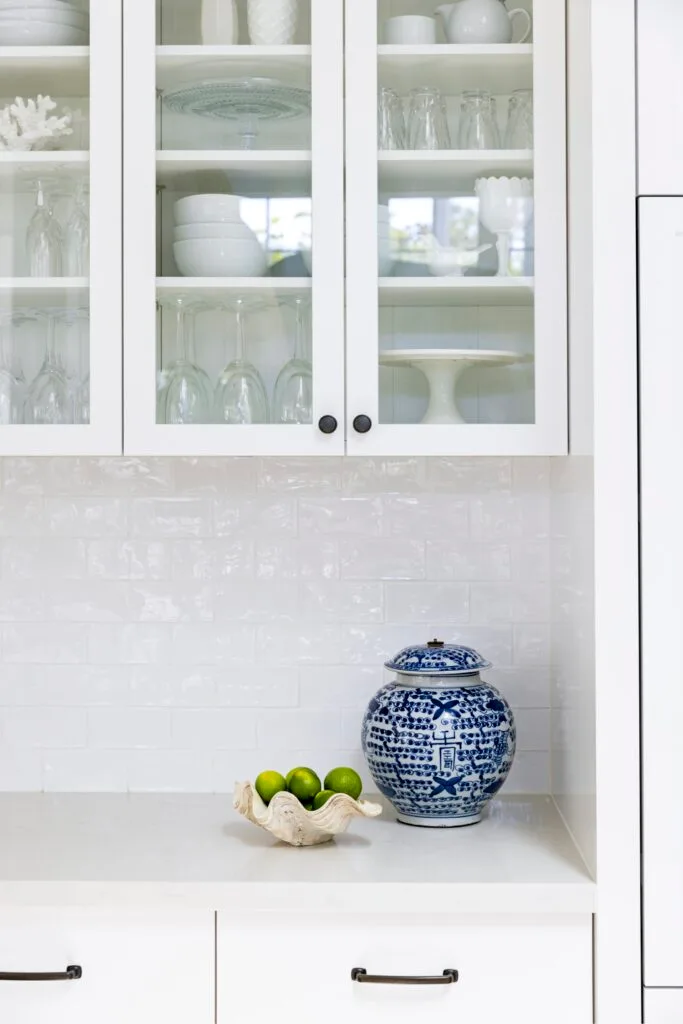
Grooved
Ideal for country and heritage looks, panelled cabinetry delivers with its grooved fronts. Classic creams, whites and navy suit this style. As a statement look, it works better in larger kitchens, and you might find yourself getting out the duster more often to keep the detailing spotless. While V-groove panelling has long clad the walls of traditional homes, it has recently moved into kitchen cabinetry. The subtle routing delivers character and interest, and works surprisingly well in contemporary kitchens as well as country- or Hamptons-style homes. Talk about versatile!
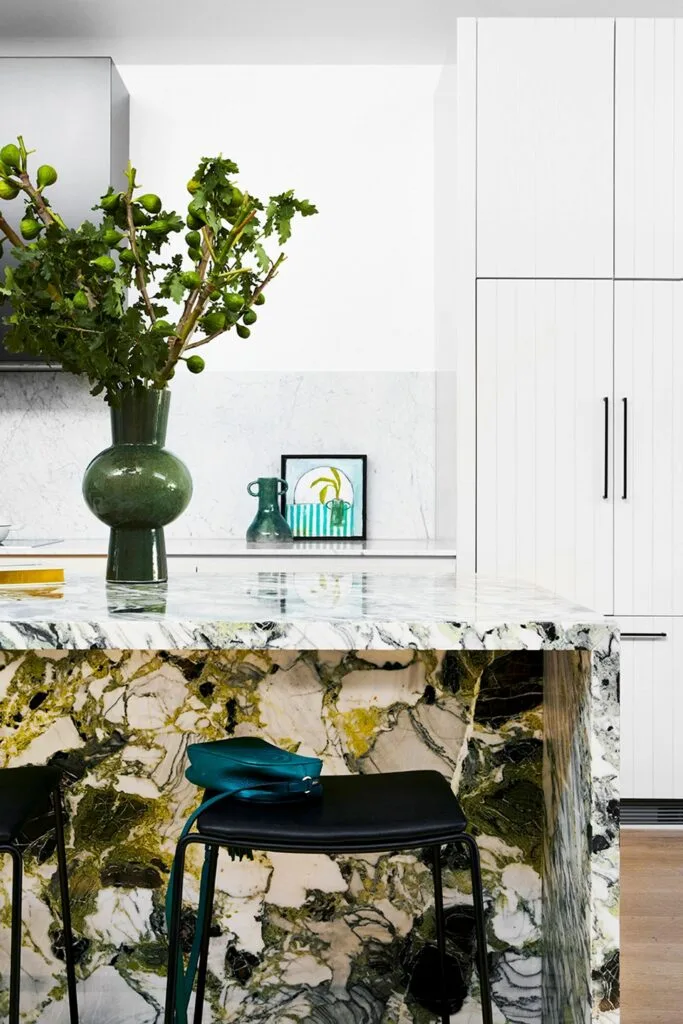
What is a cost-effective cabinet material?
Melamine is usually the most affordable, followed by two-pack polyurethane finishes. Timber is a greater investment than veneer, though its longevity is reflected in the price. Lighting cupboard interiors adds an extra trade (and cost), as do special touches, such as fluting or mesh inlays.
What colour cabinets are in right now?
Using colour can make a kitchen uniquely yours, and while timber cabinetry continues to trend, painted looks are also in the spotlight now more than ever. Specifically, says Giorgia, “there’s a rising demand for soft green tones and blue hues as timeless alternatives that diverge from the traditional white aesthetic”.

Deep berry tones, bold burgundy, buttery yellows and warm browns are also popular, offering richness, character and a nostalgic nod to retro style. Bear in mind that the finish can change up the look, often drastically. “It’s important to know where your natural and synthetic light comes from, how it moves during the day and what parts of the kitchen are in direct light,” explains Kathryn. “Any areas that have plenty of light should be a matte or satin finish, as anything too high gloss will be glary.”
Can you just get kitchen cabinet doors?
You can certainly just replace your kitchen cupboard doors. You would do this if they’re broken, have rusty hinges or are in poor condition in some way. Before going ahead you’ll need to make sure the skeleton of the cupboards are in good condition so they’ll last for years to come. Fresh, new cabinet doors is also a way give your entire kitchen a new look without the cost of redoing all of the joinery.
Is it cheaper to just replace cabinet doors?
If sticking to a tighter budget is front-of-mind, replacing just kitchen cabinet doors rather than all of the cabinetry is an excellent way to update your kitchen in a more affordable way. You’ll save a significant amount by doing this. The cost of the labour to remove all of the existing joinery, plus the material costs adds up to thousands of dollars. Cabinetry is usually a large portion of a kitchen renovation budget, so if you have the option to just replace the doors and still get a look you’re pleased with, it’s financially beneficial.
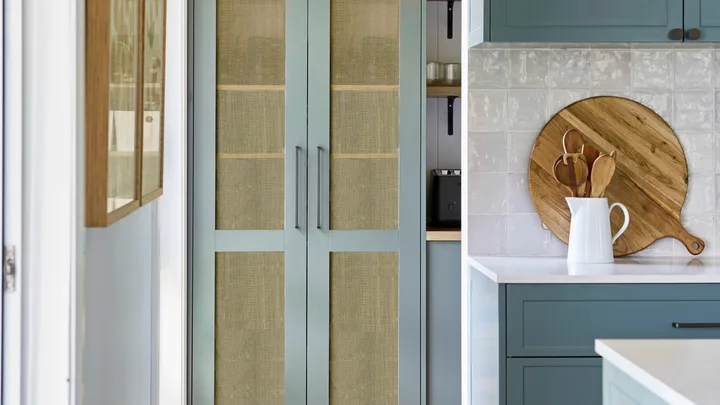 Photography: Jason Ierace / Styling: Alice Ierace
Photography: Jason Ierace / Styling: Alice Ierace

